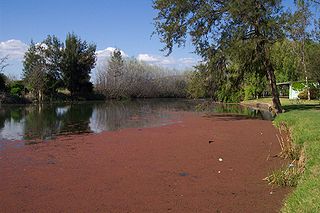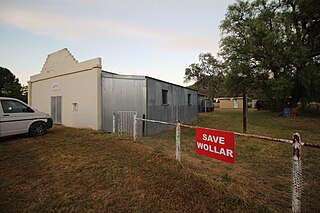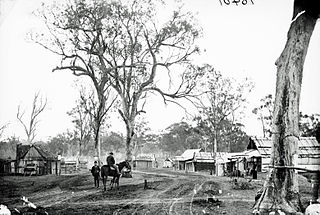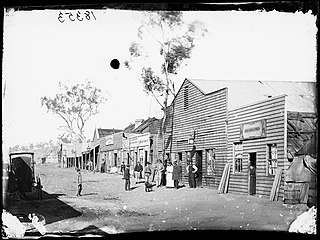
Cudgegong River, a perennial stream that is part of the Macquarie catchment within the Murray–Darling basin, is located in the central western and Orana districts of New South Wales, Australia.

Mudgee is a town in the Central West of New South Wales, Australia. It is in the broad fertile Cudgegong River valley 261 km (162 mi) north-west of Sydney and is the largest town in the Mid-Western Regional Council local government area as well as being the council seat. At the 2021 Census, its population was 11,457. The district lies across the edge of the geological structure known as the Sydney Basin.

Gulgong is a 19th-century gold rush town in the Central Tablelands and the wider Central West regions of the Australian state of New South Wales. The town is situated within the Mid-Western Regional Council local government area. It is located about 300 km (190 mi) north west of Sydney, and about 30 km north of Mudgee along the Castlereagh Highway. At the 2021 census, Gulgong had a population of 2,680.

Hill End is a former gold mining town in New South Wales, Australia. The town is located in the Bathurst Regional Council local Government area.

The Mid-Western Regional Council is a local government area in the Central West region of New South Wales, Australia. The area is located adjacent to the Castlereagh Highway that passes through the middle of the area in an approximate southeast–northwest direction.

Rylstone is a small town in New South Wales, Australia, in the Central Tablelands region within the Mid-Western Regional Council local government area. It is located on the Bylong Valley Way road route. At the 2021 census, Rylstone had a population of 904.

Baerami is a locality in the Muswellbrook Shire in the Upper Hunter region of New South Wales, Australia.
Tallawang is an historical locality north of Gulgong in central western New South Wales, Australia. The place name is derived from an aboriginal word for "apple gum".

Leadville is a town in New South Wales, Australia. The town is located in the Warrumbungle Shire local government area, 376 kilometres (234 mi) north west of the state capital, Sydney. At the 2016 census, Leadville and the surrounding area had a population of 169.

Wollar is a village in New South Wales, Australia. The town is located 316 kilometres (196 mi) north west of the state capital Sydney and 48 kilometres (30 mi) north-east of the regional centre of Mudgee, near the Goulburn River National Park. At the 2006 census, Wollar and the surrounding region had a population of 304. By the 2016 census the village of Wollar and district was reduced to 69 persons living in 50 private dwellings.
Wyaldra Creek is a creek in the Gulgong district of New South Wales, Australia.
David Hugh Spring was an Australian politician, member of the New South Wales Legislative Assembly.

New South Wales experienced the first gold rush in Australia, a period generally accepted to lie between 1851 and 1880. This period in the history of New South Wales resulted in a rapid growth in the population and significant boost to the economy of the colony of New South Wales. The California Gold Rush three years prior signaled the impacts on society that gold fever would produce, both positive and negative. The New South Wales colonial government concealed the early discoveries, but various factors changed the policy.

Canadian Lead is a 19th-century gold rush town in rural New South Wales, Australia. It is 301 km to Sydney.

Henry Beaufoy Merlin (1830–1873) was an Australian photographer, showman, illusionist and illustrator. In the 1850s he worked as a theatrical showman and performer in Sydney, Newcastle and Maitland. In 1863 he was the first person to introduce Pepper's ghost to Australia. After this, he took up photography and between 1869 and 1872 turned the American Australasian Photographic Company into one of the most respected studios in Australia. Between 1872 and 1873 he worked extensively documenting the goldfields and mining towns of New South Wales. In 1873, as an employee of Bernhardt Holtermann, he photographed Sydney and many rural New South Wales towns. He died on 27 September 1873.

The Holtermann Collection is the name given to a collection of over 3,500 glass-plate negatives and albumen prints, many of which depict life in New South Wales goldfield towns. It also includes numerous photographs of Australian rural towns and the cities of Sydney and Melbourne taken between 1871 and 1876. The collection is held by the State Library of New South Wales.
Thomas Frederic De Courcy Browne was an Irish-born Australian politician and journalist.

Yarrabin is a ghost town near the junction of the Meroo and Cudgegong rivers in the New South Wales Orana Region. The village of Merrendee was established after the discovery of gold in that area around 1851 and was located approximately 23 miles west of Mudgee. The locality was renamed Yarrabin by postal authorities in 1923.

The Greatest Wonder of the World and American Tobacco Warehouse and Fancy Goods Emporium are heritage-listed adjacent shops at 123-125 Mayne Street, Gulgong, Mid-Western Regional Council, New South Wales, Australia. They were built from 1870 to 1878. They have been refurbished to house the Gulgong Holtermann Museum, with new galleries constructed at the back to house the UNESCO listed HOLTERMANN COLLECTION. The original buildings were added to the New South Wales State Heritage Register on 21 October 2016.
Lidsdale is a locality within the City of Lithgow Local Government Area of New South Wales, Australia. It lies to the north of Wallerawang. Its area, as defined for postal and statistical purposes, includes the historic locality of Kerosene Vale and the small rural areas known as Springvale and Angus Place. In 2021, its population was 471.


















